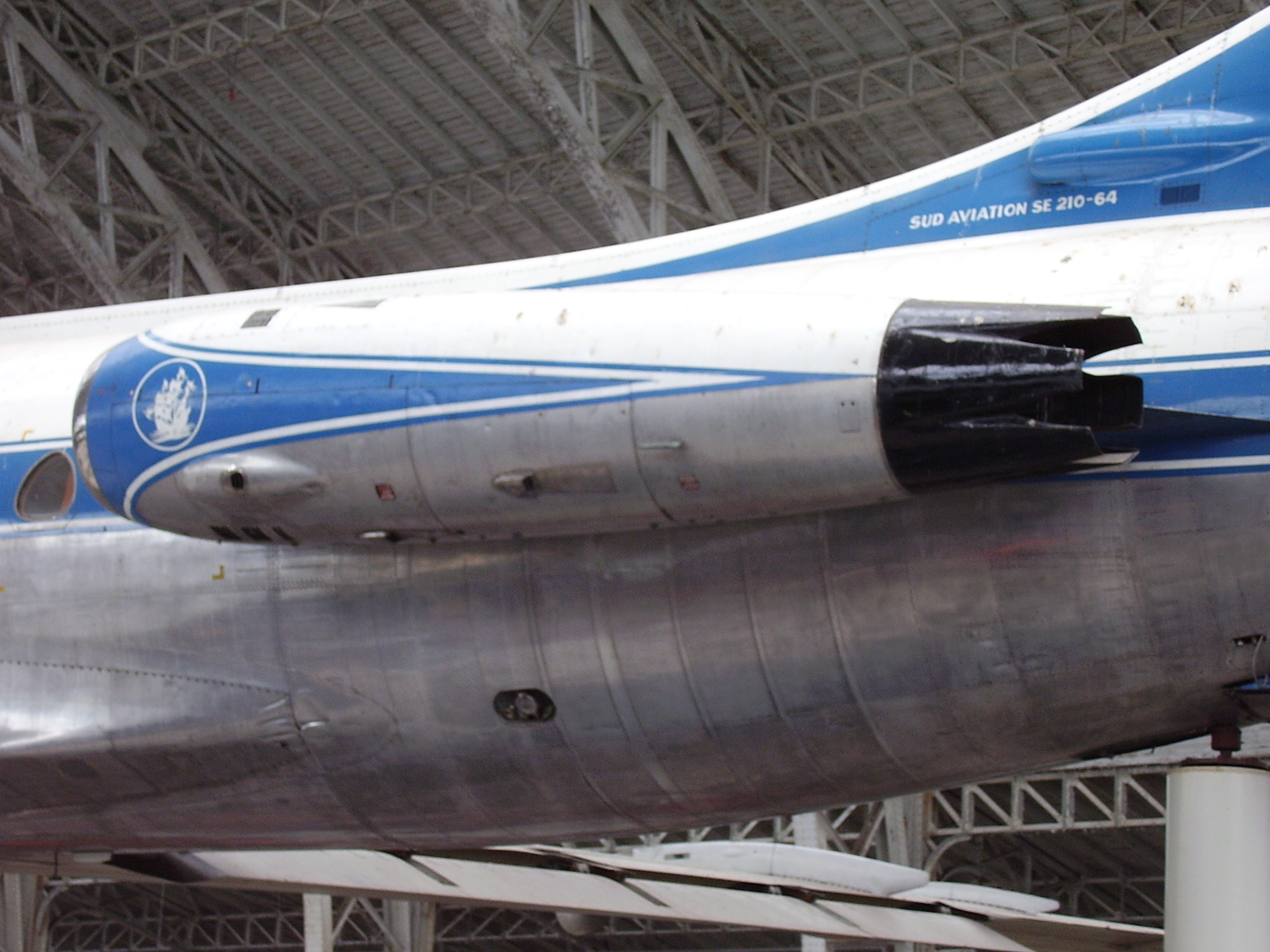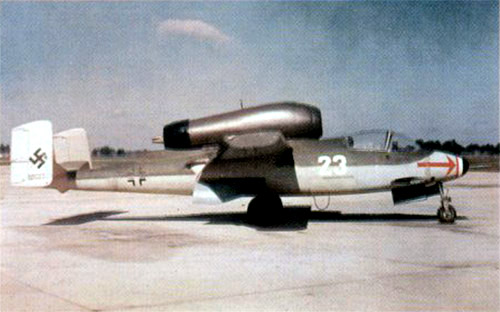Podded engine on:
[Wikipedia]
[Google]
[Amazon]
 A podded engine is a
A podded engine is a

 An early example of fuselage mounting, the Junkers Ju 287, had two of its four engines mounted on the front fuselage. The same position was used for two of the three engines on the
An early example of fuselage mounting, the Junkers Ju 287, had two of its four engines mounted on the front fuselage. The same position was used for two of the three engines on the
 Some jet fighters use podded engines, typically under and mounted directly to the wing. An example was the
Some jet fighters use podded engines, typically under and mounted directly to the wing. An example was the
 A podded engine is a
A podded engine is a jet engine
A jet engine is a type of reaction engine, discharging a fast-moving jet (fluid), jet of heated gas (usually air) that generates thrust by jet propulsion. While this broad definition may include Rocket engine, rocket, Pump-jet, water jet, and ...
that has been built up and integrated in its nacelle
A nacelle ( ) is a streamlined container for aircraft parts such as Aircraft engine, engines, fuel or equipment. When attached entirely outside the airframe, it is sometimes called a pod, in which case it is attached with a Hardpoint#Pylon, pylo ...
. This may be done in a podding facility as part of an aircraft assembly process. The nacelle contains the engine, engine mounts and parts which are required to run the engine in the aircraft, known as the EBU (Engine Build Up). The nacelle consists of an inlet, an exhaust nozzle and a cowling which opens for access to the engine accessories and external tubing. The exhaust nozzle may include a thrust reverser
Thrust reversal, also called reverse thrust, is the temporary diversion of an aircraft engine's thrust for it to act against the forward travel of the aircraft, providing deceleration. Thrust reverser systems are featured on many jet aircraft to ...
. The podded engine is a complete powerplant, or propulsion system, and is usually attached below the wing on large aircraft like commercial airliners or to the rear fuselage on smaller aircraft such as business jet
A business jet, private jet, or bizjet is a jet aircraft designed for transporting small groups of people, typically business executives and high-ranking coworker, associates. Business jets are generally designed for faster air travel and more ...
s.
Engine Build Up
The EBU components connect the engine systems with the aircraft systems. Engine build up includes installation of an engine starter, hydraulic pumps, electrical generators and firewire and components which connect the engine to the aircraft. They include the following *electrical harnesses for control, for example a thrust request from the flight deck needs an electrical path to the electronic control on the engine. *electric cables for power, electricity generated on the engine has to connect to the aircraft electrical system. *hydraulic hoses, hydraulic fluid from the aircraft hydraulic system has to be supplied to engine-mounted pumps and then returned under high pressure to the aircraft. High pressure fluid is returned to the nacelle for actuating a thrust reverser. *fuel tube, fuel has to get from the aircraft tanks to the engine fuel pump. *air tubes, high pressure air from the engine is supplied to the aircraft environmental control system and for aircraft anti-icing.The nacelle and the engine
A nacelle is a streamlined covering for a jet engine which incorporates the air inlet and exhaust outlet for the engine. The inlet is connected to a mounting flange on the front of the engine fan case. The exhaust nozzle, which may incorporate a thrust reverser, is connected to a mounting flange on the rear of the engine exhaust case. A cowling, streamlined between the inlet and exhaust, completes the nacelle. It has opening doors which allow access for regular maintenance such as adding oil as well as unscheduled replacement of engine accessories and external tubing. How well the engine performs depends on the nacelle design. The shape of the lip on the inlet, the minimum internal area and the internal profile, are established with different engine airflows at cruise to keep pressure losses acceptable, and different incident airflow angles such as in cross-winds and during take-off rotation to keep variations in pressure across the fan face acceptable.Design and Testing of a Common Engine and Nacelle for the Fokker 100 and Gulfstream G-IV Airplanes, AIAA-89-2486, AIAA/ASME/SAE/ASEE 25th Joint Propulsion Conference, p. 3/4 Pressure losses, and hence overall pressure ratio, affect engine performance or fuel consumption for each pound of thrust. Pressure variations affect engine operability or likelihood of surging. Pressure losses in the exhaust nozzle also affect the engine performance by increasing the fuel consumption. The nacelle forms the outer flow path along the engine to ensure accessories operate within their temperature limits and fire extinguisher flows are effective.Wing-mounted podded engines
Placing engines on the wing provides beneficial wing bending relief in flight. The further the engines are away from thefuselage
The fuselage (; from the French language, French ''fuselé'' "spindle-shaped") is an aircraft's main body section. It holds Aircrew, crew, passengers, or cargo. In single-engine aircraft, it will usually contain an Aircraft engine, engine as wel ...
the greater the wing bending relief, therefore engines mounted close to the fuselage (in the wing root) provide little relief. Almost all modern large jet airplanes use engines in pods located a significant distance from the wing root for substantial wing bending relief. The pods are in front of the wing to help avoid flutter of the wing which, in turn, allows a much lighter wing structure.
Fuselage-mounted podded engines

Martin XB-51
The Martin XB-51 was an American trijet ground-attack aircraft. It was designed in 1945 and made its maiden flight in 1949. It was originally designed as a bomber for the United States Army Air Forces under specification V-8237-1 and was designa ...
.
Smaller jet airplanes like the Cessna Citation are generally not suited to podded engines below the wing because this would place the engines too close to the ground. This is also the case with aircraft designed to operate from unimproved grass or gravel runway
In aviation, a runway is an elongated, rectangular surface designed for the landing and takeoff of an aircraft. Runways may be a human-made surface (often asphalt concrete, asphalt, concrete, or a mixture of both) or a natural surface (sod, ...
s. Instead, in these cases it is common to mount two (or occasionally four) podded engines on the rear of the fuselage
The fuselage (; from the French language, French ''fuselé'' "spindle-shaped") is an aircraft's main body section. It holds Aircrew, crew, passengers, or cargo. In single-engine aircraft, it will usually contain an Aircraft engine, engine as wel ...
, where they are less likely to be damaged by ingesting foreign objects from the ground.
This mounting location provides no wing bending relief but, following an engine failure, does offer much less yaw due to asymmetric thrust than would wing-mounted engines. To face the local flow of air, most engines on the rear of a fuselage are installed slightly nose-high. The local airflow at the airplane's tail is typically descending with respect to the centerline of the aircraft's fuselage
The fuselage (; from the French language, French ''fuselé'' "spindle-shaped") is an aircraft's main body section. It holds Aircrew, crew, passengers, or cargo. In single-engine aircraft, it will usually contain an Aircraft engine, engine as wel ...
.
Overwing podded engines
Unusual examples of engine placement are the VFW-614 and Hondajet which mount the engines above the wing. The Antonov An-72 and Boeing YC-14 also place their engines above the wings, but in a high-lift, orSTOL
A short takeoff and landing (STOL) aircraft is a fixed-wing aircraft that can takeoff/land on short runways. Many STOL-designed aircraft can operate on airstrips with harsh conditions (such as high altitude or ice). STOL aircraft, including tho ...
, configuration where the engine exhaust passes over the upper surface of the blown flaps. This placement uses the Coandă effect to give a lower minimum flight speed and decrease the length of runway needed for takeoff and landing.
Over-fuselage podded engines
Another unusual scheme is to mount the engine in a pod above the fuselage. The Heinkel He 162, Virgin Atlantic GlobalFlyer, and Cirrus Vision SF50 are three examples. In general, the idea is to mount the engine where it will receive good air flow, be distant from the ground to avoid foreign object damage, and not occupy fuselage space.Military aircraft
 Some jet fighters use podded engines, typically under and mounted directly to the wing. An example was the
Some jet fighters use podded engines, typically under and mounted directly to the wing. An example was the Messerschmitt Me 262
The Messerschmitt Me 262, nicknamed (German for "Swallow") in fighter versions, or ("Storm Bird") in fighter-bomber versions, is a fighter aircraft and fighter-bomber that was designed and produced by the German aircraft manufacturer Messers ...
, which had the nacelles mounted directly to the undersides of the wings, with no pylons being used. The A-10 Thunderbolt II
The Fairchild Republic A-10 , also infamously known under the nickname , is a single-seat, twinjet, twin-turbofan, straight wing, straight-wing, Subsonic aircraft, subsonic attack aircraft developed by Fairchild Aircraft, Fairchild Republic ...
ground-attack aircraft
An attack aircraft, strike aircraft, or attack bomber is a tactical military aircraft that has a primary role of carrying out airstrikes with greater precision than bombers, and is prepared to encounter strong low-level air defenses while pres ...
uses fuselage-mounted podded turbofan engines. The Heinkel He 162 had a single BMW 003E jet engine in a pod mounted over the fuselage.
Stealthy designs do not use podded engines. Instead the engines are contained within the fuselage to minimize radar cross section
Radar cross-section (RCS), denoted σ, also called radar signature, is a measure of how detectable an object is by radar. A larger RCS indicates that an object is more easily detected.
An object reflects a limited amount of radar energy b ...
.
Many military transport aircraft
A military transport aircraft, military cargo aircraft or airlifter is a military aircraft, military-owned transport aircraft used to support military operations by airlifting troops and military equipment. Transport aircraft are crucial to m ...
, bomber
A bomber is a military combat aircraft that utilizes
air-to-ground weaponry to drop bombs, launch aerial torpedo, torpedoes, or deploy air-launched cruise missiles.
There are two major classifications of bomber: strategic and tactical. Strateg ...
s, and tankers use podded engines.
References
{{DEFAULTSORT:Podded Engine Aircraft engines Aircraft configurations